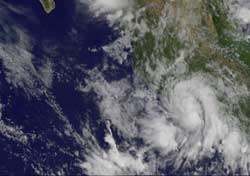Tropical Depression 8E Forms On Mexican Coastline, Watches Up

This GOES-11 image from Aug. 31 at 12:15 p.m. EDT, shows Tropical Depression 8E as a rounded swirl of clouds hugging Mexico's southwestern coastline. Credit: NASA/NOAA GOES Project <br>
Forecasters noticed the depression develop more rounded characteristics on imagery from NOAA's GOES-11 satellite today. The image was created by the NASA GOES Project at NASA's Goddard Space Flight Center, Greenbelt, Md.
On Aug. 30, NASA's Tropical Rainfall Measuring Mission (TRMM) satellite noticed some isolated areas of heavy rainfall within the low pressure area before it organized. Some areas had rainfall rates of 2 inches (50 mm) per hour.
Today, August 31 at 11 a.m. EDT, Tropical Depression 8E had maximum sustained winds near 35 mph. It was located just 75 miles (120 km) west-northwest of Zihuatanejo, Mexico, near 18.0 North and 102.7 West. It was moving northwest near 7 mph (11 kmh) and is expected to crawl in that direction over the next couple of days, making rainfall a problem for coastal areas.
Tropical Depression 8E is forecast to hug the western Mexico coastline over the next couple of days, and not strengthen because of its proximity to land. It will, however bring heavy rainfall to coastal sections of the Mexican states of Guerrero, Michoacan and Colima. The National Hurricane Center expects 4 to 6 inches with isolated maximum amounts of 12 inches.
The depression is expected to be short-lived because of its interaction with land, and the National Hurricane Center forecasts it to become a remnant low by late Thursday.
Text credit: Rob Gutro, NASA's Goddard Space Flight Center, Greenbelt, Md.
Media Contact
All latest news from the category: Earth Sciences
Earth Sciences (also referred to as Geosciences), which deals with basic issues surrounding our planet, plays a vital role in the area of energy and raw materials supply.
Earth Sciences comprises subjects such as geology, geography, geological informatics, paleontology, mineralogy, petrography, crystallography, geophysics, geodesy, glaciology, cartography, photogrammetry, meteorology and seismology, early-warning systems, earthquake research and polar research.
Newest articles

Superradiant atoms could push the boundaries of how precisely time can be measured
Superradiant atoms can help us measure time more precisely than ever. In a new study, researchers from the University of Copenhagen present a new method for measuring the time interval,…

Ion thermoelectric conversion devices for near room temperature
The electrode sheet of the thermoelectric device consists of ionic hydrogel, which is sandwiched between the electrodes to form, and the Prussian blue on the electrode undergoes a redox reaction…

Zap Energy achieves 37-million-degree temperatures in a compact device
New publication reports record electron temperatures for a small-scale, sheared-flow-stabilized Z-pinch fusion device. In the nine decades since humans first produced fusion reactions, only a few fusion technologies have demonstrated…





















